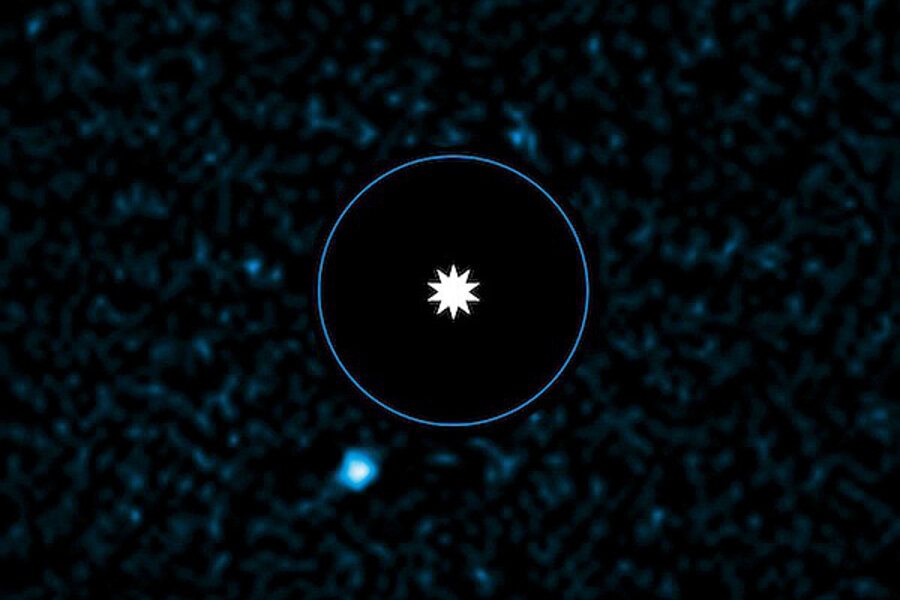Super-hot exoplanet spotted only 300 light-years away
Loading...
Scientists have spotted a steaming hot planet with an orbit bigger than anything in our solar system, according to an upcoming paper from Astrophysical Journal Letters.
Of the thousand or so exoplanets scientists have found, nearly all were discovered using indirect methods, but this one was seen in a telescope – the Very Large Telescope, which is actually a system of four telescopes that can be yoked together. In pictures taken with the VLT, this steamy giant of a planet is the faint but clear dot close to the star HD 95086 – hence the planet's name, HD95086b. Later observations showed both dots moving together across the sky in a way that suggested that one was in orbit: a planet, not a companion star, the scientists say.
From the brightness, they calculated that it is about 1,300 degrees F (700 degrees C) at the surface, "cool enough for water vapor and possibly methane to exist in its atmosphere," says Gaël Chauvi, a member of the research team that found the planet.
HD95086b is young enough – between 10 and 17 million years old, not even one percent as old as Earth – that it offers tantalizing hints about how planets form.
"It might have grown by aggregating rocks into a solid core and then slowly accumulating a gassy atmosphere," explains Anne-Marie Lagrange, another team member. "It's equally possible it started as a blob of gases, born out of gravitational instabilities in the proto-planetary disc."
It's tremendously far away from its parent star – more than twice the distance between our sun and Neptune – but Dr. Lagrange says they can't tell yet whether it has always been in its current location or it whether it was moved by interactions with other planets.
The team hasn't yet found any other planets within this one's enormous orbit, but they're still looking. When the SPHERE instrument is added to the VLT later this year, Dr. Chauvi says, "Maybe it will reveal inner planets in the system – if they exist."
A 'beacon' of planetology
Of the nearly one thousand planets found orbiting other stars, only 12 have been spotted directly. The rest were found by seeing how they affected the stars they orbit.
Here's how it works: If the planet cuts between its star and Earth, it blocks the light shining our way. Scientists keep a sharp eye out for these dips in stellar brightness, telltale proof of a planet "transiting" its star. The other common approach for planet-spotting is to look for the "wobble" caused when a planet tugs on its star. But both of these are considered indirect methods of planetary observation, since scientists are actually seeing a star change, not a planet itself.
That's what makes this find so extraordinary. HD 95086b was directly imaged by the same team of scientists that captured the first picture of an exoplanet nine years ago.
"Since only a handful of planets have been discovered by direct imaging," says Julien Rameau of the Planetology and Astrophysics Institute in Grenoble, France, "every such discovery is a beacon, illuminating the path toward understanding giant planets and how they form."
"Directly imaging planets is an extremely difficult technique that requires the most precise instruments, whether your telescope is ground-based or in orbit," notes Dr. Rameau, the lead author of the upcoming paper.
The VLT, located in the Atacama Desert of northern Chile, uses four linked telescopes with a primary mirror 30 feet (8.2 meters) across. The four usually operate independently, since each can detect objects 4 billion times fainter than can be seen with the naked eye. When they operate together, they can see more precisely than any other telescope on Earth. The four separate optical telescopes were given astronomical names from the Mapuche language: Antu, Kueyen, Melipal and Yepun.
To remove most of the blurring effects of the atmosphere, the team used the NACO instrument, attached to one of the four constituent telescopes of the VLT. With NACO – the Nasmyth Adaptive Optics System and Coude Near Infrared Camera – researchers can produce infrared images as sharp as those taken by orbiting telescopes like Hubble.
To see this exoplanet, the team used infrared light and a technique called differential imaging, which improves the contrast between the planet and the otherwise overwhelming host star. By looking at the brightness of the planet and its star, the team was able to calculate that the planet has about 4.5 times the mass of Jupiter.






